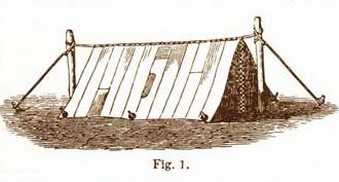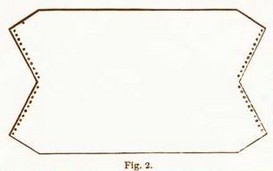TENTS
Tents.-Large Tents.-The art of tent-making has greatly advanced since the days of the old-fashioned bell-tent, which is so peculiarly objectionable, as to make it a matter of surprise that it was ever invented and used. It is difficult to pitch; it requires many tent-pegs; it has ropes radiating all round it, over which men and horses stumble; and it is incommodious and ugly.
In choosing a tent, select one that will stand in some sort of shape with only four pegs, or with six at the very utmost; it should admit of being pegged close to the ground without any intervening 'fly'; it is no objection that it should require more than one pole; and, when considering how much weight it will be possible to carry, it must be borne in mind that the tent will become far heavier than it is found to be in the peculiarly dry atmosphere of a tent-maker's show-room. It is very convenient that a tent should admit of being pitched in more than one form: for instance, that one side should open and form an awning in hot weather; also, that it should be easy to attach flys or awning to the tent to increase its available size during the daytime. All tents should be provided with strong covers, for pack-ropes are sure to fray whatever they press against; and it is better that the cover should suffer than the tent itself.
One side of the ordinary conical tents (fig. 1), of a front view of fig. 5, and of pyramidal tents (fig. 6), are represented by the line A B C. Those that have a “fall” (fig. 2), by the lines C D L F. Gipsy-tents, as described p. 161, umbrella-tents (fig. 4), and Jourts, p. 157, by the lines G H B K. Marquees (fig. 3), and a side view of fig. 5, by G L B M.
Small Tents.-For tents of the smallest size and least pretensions, nothing can be better than the one represented in fig. 1: the ends are slit down their middles, and are laced  or buttoned together, so that, by unfastening these, the tent spreads out to a flat sheet of the form of fig. 2, well adapted for an awning, or else it can be simply unrolled and used with the bedding. It is necessary that a tent should be roomy enough to admit of a man undressing himself, when wet through, without treading upon his bed and drenching it with mud and water; and therefore a tent of the above description is found to be unserviceable, if less than about 7
or buttoned together, so that, by unfastening these, the tent spreads out to a flat sheet of the form of fig. 2, well adapted for an awning, or else it can be simply unrolled and used with the bedding. It is necessary that a tent should be roomy enough to admit of a man undressing himself, when wet through, without treading upon his bed and drenching it with mud and water; and therefore a tent of the above description is found to be unserviceable, if less than about 7 feet long, or ending in a triangle of less than 5 ½ feet in the side. Peat, the saddler in Bond Street, once made them; they cost 2l. 10s., and weighed 9 lbs. when dry. They are liable to bag in the side when the wind is high: a cross-pole or two sticks, following the seams of the canvas in the above sketch, would make them tauter.
feet long, or ending in a triangle of less than 5 ½ feet in the side. Peat, the saddler in Bond Street, once made them; they cost 2l. 10s., and weighed 9 lbs. when dry. They are liable to bag in the side when the wind is high: a cross-pole or two sticks, following the seams of the canvas in the above sketch, would make them tauter.

